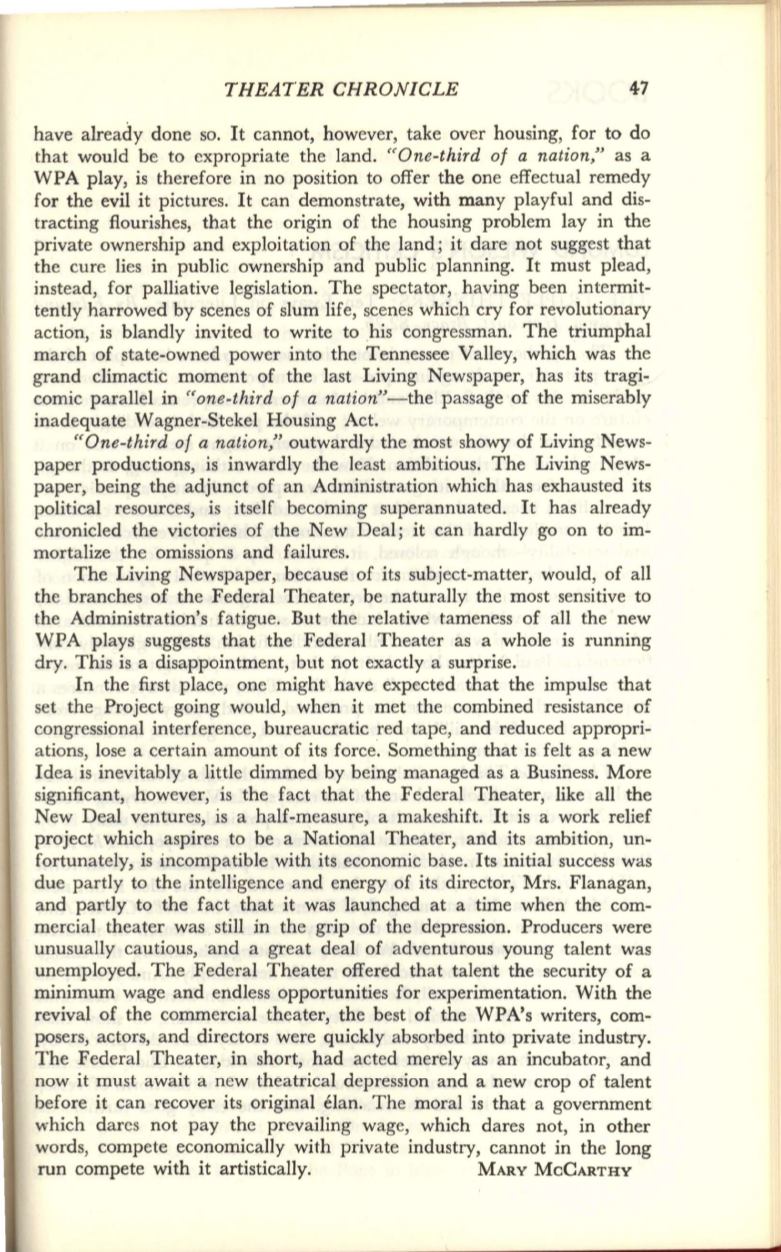
THEATER CHRONICLE
47
have already done so. It cannot, however, take over housing, for to do
that would be to expropriate the land.
"One-third of a nation,"
as a
WPA play, is therefore in no position to offer the one effectual remedy
for the evil it pictures. It can demonstrate, with many playful and dis–
tracting flourishes, that the origin of the housing problem lay in the
private ownership and exploitation of the land; it dare not suggest that
the cure lies in public ownership and public planning. It must plead,
instead, for palliative legislation. The spectator, having been intermit–
tently harrowed by scenes of slum life, scenes which cry for revolutionary
action, is blandly invited to write to his congressman. The triumphal
march of state-owned power into the Tennessee Valley, which was the
grand climactic moment of the last Living Newspaper, has its tragi–
comic parallel in
" one-third of a nation"- the
passage of the miserably
inadequate Wagner-Stekel Housing Act.
" One-third of a nation,"
outwardly the most showy of Living News–
paper productions, is inwardly the least ambitious. The Living News–
paper, being the adjunct of an Administration which has exhausted its
political resources, is itself becoming superannuated. It has already
chronicled the victories of the New Deal; it can hardly go on to im–
mortalize the omissions and failures.
The Living Newspaper, because of its subject-matter, would, of all
the branches of the Federal Theater, be naturally the most sensitive to
the Administration's fatigue. But the relative tameness of all the new
WPA plays suggests that the Federal Theater as a whole is running
dry. This is a disappointment, but not exactly a surprise.
In the first place, one might have expected that the impulse that
set the Project going would, when it met the combined resistance of
congressional interference, bureaucratic red tape, and reduced appropri–
ations, lose a certain amount of its force'. Something that is felt as a new
Idea is inevitably a little dimmed by being managed as a Business. More
significant, however, is the fact that the Federal Theater, like all the
New Deal ventures, is a half-measure, a makeshift. It is a work relief
project which aspires to be a National Theater, and its ambition, un–
fortunately, is incompatible with its economic base. Its initial success was
due partly to the intelligence and energy of its director, Mrs. Flanagan,
and partly to the fact that it was launched at a time when the com–
mercial theater was still in the grip of the depression. Producers were
unusually cautious, and a great deal of adventurous young talent was
unemployed. The Federal Theater offered that talent the security of a
minimum wage and endless opportunities for experimentation. With the
revival of the commercial theater, the best of the WPA's writers, com–
posers, actors, and directors were quickly absorbed into private industry.
The Federal Theater, in short, had acted merely as an incubator, and
now it must await a new theatrical depression and a new crop of talent
before it can recover its original elan. The moral is that a government
which dares not pay the prevailing wage, which dares not, in other
words, compete economically with private industry, cannot in the long
run compete with it artistically.
MARY MCCARTHY


